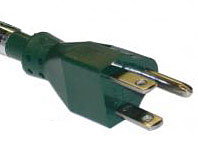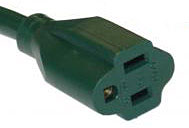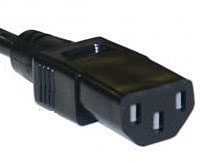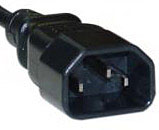The Technical Side of Power Cords
This month is all about the ins and outs of power/extension cords. This
information can get a little technical, so bear with us. This article will
comprise of short introductions to concepts, followed by what will
essentially be a glossary of terms.
There are 2 basic groups of connector designations that we'll discuss here:
NEMA and IEC.
NEMA
Established by the National Electrical Manufacturers Association (N.E.M.A.),
NEMA describes various connectors used on power cords throughout North
America and some other countries. NEMA devices range in amperages from 15-60,
and in voltages from 125-600. Different, non-interchangeable plug computer power
cord types are created based on specific amperages/voltages, and are each given
a NEMA designation. That way, something that calls for 125 volts cannot be
mistakenly inserted into a 220 volt receptacle.
There are two main classifications of NEMA power cord types. One is called a
straight-blade, the other is locking. Straight blades are the type most found
in regular consumer electronics, whereas locking devices are reserved for
more industrial uses where a plug accidentally falling out of a receptacle is
a bigger worry. The locking-type will have curved blades that allow the plug
to be twisted and locked into the receptacle. An "L" preceding the
NEMA code indicates a locking connector.
So, let's discuss these NEMA codes. The most common NEMA power cords are
the 5-15 and 5-20 designations. The first number indicates the plug
configuration. This includes the number of poles and wires and the voltage. A
grounding type device will be described as two-pole, three-wire or four-pole,
five-wire etc. A non-grounding device will be two-pole, two wire or
three-pole, three-wire etc. The second number in the code indicates the amp
rating of the device, and is followed by an "R" for receptacle, or
a "P" for a plug.
For example: 5-15R is a 125V, 2-pole, 3-wire receptacle rated at 15 amps and
is the most commonly found power outlet in houses in the U.S.
NEMA Designations
There are several designation groups within NEMA. We will cover only the most common.
NEMA 1
NEMA 1 devices are 2-wire non-grounding devices rated for 120 volts. The standard 2-blade plug found on a basic lamp or a non-grounded laptop power cord are both NEMA 1-15P.

NEMA 1-15P
NEMA 5
NEMA 5 devices are 3-wire grounding devices rated for 125 volts. Sometimes called an Edison plug, the 5-15P is the most common type of plug used in the U.S. A NEMA 5-15P is a grounded version of the 1-15P. These are the basic plugs found on most electronics (computers, surge protectors, receivers, etc) as well as on standard extension cords .

NEMA 5-15P

NEMA 5-15R
NEMA 14
NEMA 14 devices are 4-wire grounding devices. 14-30 and 14-50 are the common non-locking devices used in electric clothes dryers or electric stoves, respectively. Allowing for both 120/240 volts, the biggest difference between 14-30 and 14-50 (besides the amperage) is that the 14-30 has an "L" shaped top blade, whereas the 14-50 has a straight center blade. This forbids the accidental use of a 14-30 on a 14-50 receptacle. NEMA 14-50 devices are often found in RV parks for powering large recreational vehicles.
NEMA TT-30
Even more commonly used in RV parks are the NEMA TT-30power cord type. Rated for 125 volts, nearly all RV's use this 30 amp grounding device for power.
IEC
IEC is the designation given to connectors used in some appliances and computers/laptops. Established by the International Electro technical Commission (IEC), these designations use the letter "C" followed by a number in their codes. Again, we will not go over all types of power cord connectors.
C13 and C14 Connectors
C14 connectors are found in use on most desktop computer power cords . The familiar receptacle on the back of the printers, computers, UPS devices or computer monitors is a C14 connector. The end that plugs into these receptacles is a C13 connector.

C13 Connector

C14 Connector
C15 and C16 Connectors
3-prong C16 receptacles can be found on some hot appliances, such as electric tea-kettles and the corresponding plug for these receptacles is a C15. These are similar to C13/C14 connectors but are rated for a higher temperature, which is why they are used on "hot" appliances.
C17 and C18 Connectors
These connectors are similar to C13/C14 except that they don't have a third pin used for grounding. The Xbox 360 uses this type of connector for it's power block.
C19 and C20 Connectors
These are used in some server rooms where higher currents are required. These connectors are squared versions of C13/C14 connectors.
C7 Connector
This is the figure-eight connector found on non-grounded laptop power supplies, some video game consoles, etc.

C7 Connector
C5 Connector
This is the clover-leaf looking plug found on grounded laptop power supplies. C6 is the corresponding receptacle.

C5 Connector
Jacket Types and Wire Gauges
There are many different jackets used in power cables. To distinguish the various jacket types and features, a series of code letters is used to describe the jacket. Each letter has a distinct meaning, as defined in the UL standard # 62 (UL62), and is stamped directly on the jacket. The letters can describe the material used in the jacket, the voltage rating, the jacket's resistance to the elements, or other factors. Below is a short glossary of some of the different codes you will find:
- S - Service Grade. This means the cord is 600-volt rated.
- SJ - Junior Service. Meaning 300-Volt rated.
- T - Thermoplastic. The wire is coated in PVC.
- P - Parallel. These are the types of cords where each conductoris insulated separately as in a typical lamp cord.
- O - Oil-Resistant. One "O" means the jacket is resistant to oil. Two "O"s means the jacket as well as the insulation inside the cord are oil resistant.
- W - Weather-Resistant. Essentially, these cords are outdoor-rated. They include resistance to wet conditions as well as UV protection.
- V - Vacuum Type. Flexible jacket originally used for vacuum cleaners, but is now found on a wide variety of products.
| Jacket | Permitted Wire Gauge | Permitted # of Conductors |
| SPT-1 | 20-18 | 2 or 3 |
| SPT-2 | 18-14 | 2 or 3 |
| SPT-3 | 18-10 | 2 or 3 |
| NISPT-1 | 18-16 | 2 or 3 |
| NISPT-2 | 18-16 | 2 or 3 |
| SVT | 18-16 | 2 or 3 |
| SJT | 18-10 | 2 to 6 |
| ST | 18-2 | 2 or more |
For example, some types of power cords might have SJTW on the jacket. This would indicate a junior service grade wire cord, rated for 300 volts, with a PVC jacket that is weather resistant. The -1, -2, and -3 listed above indicates the thickness of the jacket. -1 is thin, -2 is medium and -3 is thick.
Amps vs Wire Gauge
There is a direct correlation between cable length, amperage and wire gauges.
The following list is a basic breakdown of the relationship of amperage vs
wire gauge. These are only basic guidelines, so as the length of the cord is
increased either the amps will decrease or the wire gauge will have to be
increased.
These different jackets can accommodate different wire gauges and number of
wires (conductors) inside the power cord. Below is a chart of various jacket
types, what wire gauges are permitted for use inside, and how many conductors
are allowed:
| Amperage | Recommended Wire Gauge |
| 7a | 20 AWG |
| 10a | 18 AWG |
| 13a | 16 AWG |
| 15a | 14 AWG |
| 20a | 12 AWG |
Wire Color-Coding
For safety and convenience reasons, wire color-coding standards were developed for the jackets of the individual conductors inside power cords. Below is a list of the US and European color-coding standards. Please note that these apply to most power cords in the US and Europe. Color-coding may vary in certain applications.
| Wire | USA Color | EU Wire Color |
| Live Wire | Black | Brown |
| Negative Wire | White | Blue |
| Ground Wire | Green | Yellow/Green |



